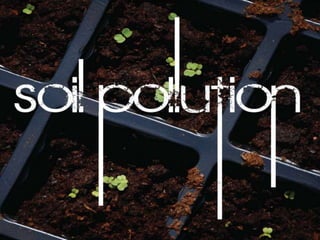
Presentation
- 2. What is Soil? Soil is the mixture of minerals, organic matter, gases, liquids and a myriad of micro- and macro- organisms that can support plant life.it performs four important functions: a medium for plant growth; water storage, supply and purification; modifier of the atmosphere; a habitat for organisms that take part in decomposition and habitat for other organisms.
- 3. Then What is Soil Pollution? Soil pollution is either solid or liquid hazardous substances mixed with the naturally occurring soil. Usually, contaminants in the soil are physically or chemically attached to soil particles, or, if they are not attached, are trapped in the small spaces between soil particles.
- 4. Reasons for Soil Pollution Soil Pollution Pesticides Herbicides Biodegradable Industrial Waste Non Biodegradable
- 5. Pesticides A pesticide is a substance or mixture of substances used to kill a pest. A pesticide may be a chemical substance, biological agent (such as a virus or bacteria), antimicrobial, disinfectant or device used against any pest. Pests include insects, plant pathogens, weeds, molluscs, birds, mammals, fish, nematodes (roundworms) and microbes that compete with humans for food, destroy property, spread or are a vector for disease or cause a nuisance. Although there are benefits to the use of pesticides, there are also drawbacks, such as potential toxicity to humans and other organisms.
- 6. Herbicides Herbicides are used to kill weeds, especially on pavements and railways. They are similar to auxins and most are biodegradable by soil bacteria. However, one group derived from trinitrotoluene have the impurity dioxin, which is very toxic and causes fatality even in low concentrations. It is highly toxic but it rapidly degrades in soil due to the action of bacteria and does not kill soil fauna. Example:- Sodium Chlorate (NaclO3), Sodium Arsinite (Na3AsO3), etc.
- 7. Side Effects of Pesticides and Herbicides Though pesticides and herbicides protect food from pests and other microbes, they can have inverse effects like: • Soil Pollution • Diseases • Food Poisoning • Long term disabilities, etc.
- 8. How can we Clean it up? • Soil can be excavated from the ground and be either treated or disposed • Soil can be left in the ground and treated in place • Soil can be left in the ground and contained to prevent the contamination from becoming more widespread and reaching plants, animals, or humans. • Containment of soil in place is usually done by placing a large plastic cover over the contaminated soil to prevent direct contact and keep rain water from seeping into the soil and spreading the contamination.
- 10. What is Industrial Waste? Industrial waste is the waste produced by industrial activity which includes any material that is rendered useless during a manufacturing process such as that of factories, mills and mines. It has existed since the outset of the industrial revolution. Sewage treatment can be used to clean water tainted with industrial waste. Some examples of industrial waste are paints, sand paper, paper products, industrial by-products, metals, radioactive wastes, etc. Industrial wastes are of two types: Biodegradable and nonbiodegradable.
- 11. Biodegradable Waste Biodegradable waste is a type of waste which can be broken down, in a reasonable amount of time, into its base compounds by micro-organisms and other living things, regardless of what those compounds may be. Biodegradable waste can be commonly found in municipal solid waste as green waste, food waste, paper waste, and biodegradable plastics. Other biodegradable wastes include human waste, manure, sewage, and slaughterhouse waste. In the absence of oxygen, much of this waste will decay to methane by anaerobic digestion.
- 12. Non-Biodegradable Waste Non-biodegradable waste will NOT break down (or won't for many many years). Examples are plastics, metal and glass. Some dangerous chemicals and toxins are also non-biodegradable, as are plastic grocery bags, Styrofoam (polystyrene), and other similar materials but will eventually break down over time.
- 13. Methods to Reduce Industrial Waste: Waste Recycling Fuel obtained from plastic waste has high octane rating. It contains no lead and is known as green fuel.
- 14. Methods to Reduce Industrial Waste: Waste Recycling (cont.) Due to recent developments made in chemical and textile industries, clothes will be made from recycled plastic waste. These will be available soon in the global textile market.
- 15. Methods to Reduce Industrial Waste: Waste Recycling (cont.) Technology Has now been developed to produce electricity from garbage. A pilot plant has been set up, where after removing ferrous metals, plastic glass, paper, etc. from garbage, it is mixed with water. It is then cultured with bacterial species for producing methane, commonly known as biogas. The remaining product is used as manure and biogas is used for producing electricity. In India, our cities and towns face endless hours of power cut. We can also see piles of garbage rotting here and there. This is a good news that we can get rid of this problem simultaneously.
